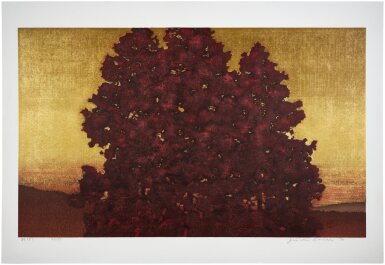Landscape to City: A Collection of 20th Century Japanese Prints
Landscape to City: A Collection of 20th Century Japanese Prints

Joichi Hoshi (1913-1979) | Cedar, Evening (Sugi, yu) | Showa period, 20th century
Lot Closed
November 18, 03:52 PM GMT
Estimate
4,000 - 5,000 GBP
Lot Details
Description
Joichi Hoshi (1913-1979)
Cedar, Evening (Sugi, yu)
Showa period, 20th century
woodblock print, embellished with gold and metallic pigments, signed in pencil in Roman script Joichi Hoshi and dated '78, with artist's rectangular red seal, titled as above, numbered 44/99
48.6 x 81.3 cm., 19⅛ x 32 in.
A large cedar tree basks in the light of a dusk evening. The setting sun seemingly casts the intricate network of leaves an intense red against the gold pigment ground. Notably, the trunk and canopy of the tree are truncated, boldly centralising the point of view of this reverent free study.
Joichi is often regarded as one of the most unique print artists of the post-war period. Known for his elegantly carved rendering of stars and constellations, his late works focused more or less solely on the study of bare trees in the autumn or winter seasons. His work reveals a strong attraction to the universal elements of nature and it has been noted that though it may seem that the artist’s ‘pictorial method is European in origin, the intensity of contemplation of a single tree is recognisably East Asian in tradition’.1 The example here is comparatively rare among Hoshi’s works, as the cedar is shown complete with a profusion of leaves.
Born in Niigata Prefecture, Hoshi worked as a school teacher in Taiwan for thirteen years. He returned to Japan after World War II where he enrolled in the oil painting department of Musashino College of Fine Arts, graduating in 1956 at the age of forty-three. He is a self-taught woodblock print artist and was represented at the Tokyo Biennale in 1960, 1963 and 1964, and Sao Paolo in 1967.
1. Lawrence Smith, The Japanese Print Since 1900: Old Dreams and New Visions, (London, 1983), p. 119.
